英语教案--优秀-电子教案.doc
高中英语教案电子版(通用7篇)
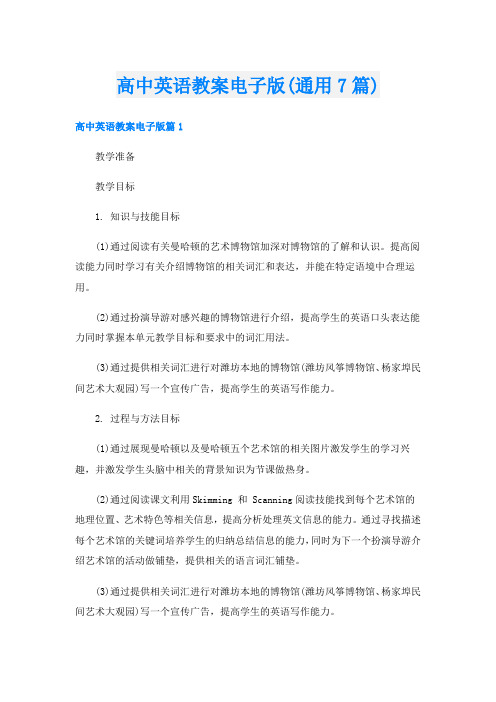
高中英语教案电子版(通用7篇)高中英语教案电子版篇1教学准备教学目标1. 知识与技能目标(1)通过阅读有关曼哈顿的艺术博物馆加深对博物馆的了解和认识。
提高阅读能力同时学习有关介绍博物馆的相关词汇和表达,并能在特定语境中合理运用。
(2)通过扮演导游对感兴趣的博物馆进行介绍,提高学生的英语口头表达能力同时掌握本单元教学目标和要求中的词汇用法。
(3)通过提供相关词汇进行对潍坊本地的博物馆(潍坊风筝博物馆、杨家埠民间艺术大观园)写一个宣传广告,提高学生的英语写作能力。
2. 过程与方法目标(1)通过展现曼哈顿以及曼哈顿五个艺术馆的相关图片激发学生的学习兴趣,并激发学生头脑中相关的背景知识为节课做热身。
(2)通过阅读课文利用Skimming 和 Scanning阅读技能找到每个艺术馆的地理位置、艺术特色等相关信息,提高分析处理英文信息的能力。
通过寻找描述每个艺术馆的关键词培养学生的归纳总结信息的能力,同时为下一个扮演导游介绍艺术馆的活动做铺垫,提供相关的语言词汇铺垫。
(3)通过提供相关词汇进行对潍坊本地的博物馆(潍坊风筝博物馆、杨家埠民间艺术大观园)写一个宣传广告,提高学生的英语写作能力。
3. 情感、态度、价值观目标通过学习,使学生了解世界的艺术馆,培养学生的文化意识和对艺术的兴趣。
同时激发学生对家乡的自豪感和热爱之情。
教学重难点教学重点:阅读课文、运用文中相关词汇进行说和写的活动以提高学生读、写、说的能力。
教学难点:在说和写的过程中如何运用相关词汇和表达方式来正确、准确、有效的介绍各个艺术馆的特点。
教学过程(一)展示学习目标与小组评价规则(二)“导入”展示曼哈顿的相关图片,展示课文中出现的5个艺术馆的图片及名字。
(三) Fast reading快速扫读课文(四)Detailed Reading: 详细阅读(五)Challenge your speaking(口语能力提升)提供参考词汇: Welcome to …This museum is located in…It displays(展出) art works in… centuries of …countries, including …It will appeal to…You shouldn’t miss…(六)Challenge your writing (英语写作能力提升)Watch the videos and then write an advertisement to introduce one of the museums in Weifang. within80 words写作参考词汇:潍坊世界风筝博物馆(Weifang World Kite Museum)杨家埠民间艺术大观园(Yangjiabu Folk Art Museum)kite 风筝 wood-print new year pictures木板年画 be located in 位于…is famous/well-known for …因…而出名 it displays/shows…展出Here you can enjoy…在这里你可以欣赏到… artist 艺术家 appeal to 吸引 tourist 游客 it’s well worth a visit 很值得参观(七)成果展示个别学生优秀作文展示(黑板展示)展示作文评分细则教师点评课后习题测评练习测评一:从文中找出相对应的短语和句子。
综合英语(四)电子教案.docx

Teaching Plan 一Unit 1-16, Book 4 Unit 1每单元题0教学重点和难点Text I Never Give In, Never, Never, Never 1. Vocabulary2.Structural analysis of the text3.The main idea of Text4.Giving answers to the questions raised about the text;5.Explaining some of the phrases and sentences in the text in one's own words;6.Key structure:1)seem的用法2)It seems that7.Key phrases:Ups and downs; address oneself to; yield to; close an accountText IIWinstonChurchill本章讨论题(思考题、作业):1.Why does the author urge people to be patie2.What is the change in the widespread mood3.Why does the author change “darker" to "st作业:Making sentences with:1.To…,it seems that • •.2.throw one's mind back 课时分配教学组织安排20 mins Vocabulary160mins Text Study60 mins Exercises30 mins Text II: reading for the main idea(s);pair discussion about the questionson the textsnt?1 referred to in Paragraph 5? terner,,7Unit 2每单元题g教学重点和难点课时分配教学组织安排Text I Space Invaders 1- Vocabulary2.Structural analysis of the text3.The main idea of Text4.Giving answers to thequestions raised about the text;5.Explaining some of thephrases and sentences in thetext in one^s own words;6.Key structure:1)whereas的用法2)In the same way that7.Key phrases: sidled up,carve out, attribute ... to, stakeda claim, to tread on, plowedinto, is ... proportional to,breathe down their necks20 mins Vocabularyl60mins Text StudyText IISpace andDistance60 mins Exercises30 mins Text II: reading for the main idea(s);pair discussion about the questionson the text木章讨论题(思考题、作业):1 ・Why does the writer tell his experience at the bank?2.H ow is the concept of personal space defined?3.What is meant by "this tendency59 in Paragraph 4? What did the author think caused this tendency?4.W hat is the characteristic of personal space as described in Paragraph 5?5.Why id personal space shrinking in general?作业:Making sentences with:1. whereas2.In the same way that…Unit 3每单元题目教学重点和难点Text IAlienation and the Internet 1. Vocabulary 2.Structuralanalysis of the text3. T he main idea of Text4. Giving answers to the questions raised about the text;5. Explaining some of the phrases and sentences in the text in on&s own words;6. Key structure: 1) .in that 的用法 2) I t is my hope that 3) All things being considered7. Key phrases: for the better, at the expense of,, be confronted with, took advantage of,, in earnest, are available for, prior to, would give...pause to thinkText IIAmericanOnline: Losing the Battles, butWinning the War 木章讨论题(思考题、作业):1. Whaf s the authors viewpoint about the ben negative side?2. What happened to the author^ friend as regi did he see about it?3. What alienated society members before the them in the information age?4. W hat is meant by the "cruel irony 95 that appc5. H ow, according to the author, can the potent 作业:Making sentences with: 1. It's my personal belief that 2. in that 3. All of this being said,…课时分 配 教学组织安排20 minsVocabulary160mins Text Study 60 mins Exercises 30 mins Text II: reading for the main idea(s); pair discussion about the questions on the textiefit of the Internet? What does he see about its ards the Internet? What negative consequences Internet gained popularity? What alienates ^ars in Paragraph 4? tial of the Internet be realized?Unit 4每单元题目教学重点和难点课时分配教学组织安排Text IA View of Mountains 1. Vocabulary2.Structural analysis of the text3.The main idea of Text4.Giving answers to thequestions raised about the text;5.Explaining some of thephrases and sentences in thetext in one's own words;6.Key structure:Only if7.Key phrases:come into his own, is brandedwith, for good, lay in, i n certainrespect, come into existence, outskirts, once and for all20 mins Vocabulary160mins Text StudyText II Statement at the 2003Session of United Nations Disarmament Commission 60 mins Exercises30 mins Text II: reading for the main idea(s);pair discussion about the questionson the text本章讨论题(思考题、作业):1.Why is a view of mountains provided by a picture so significant that it was chosen as the title of this essay?2.W hy are Yamahata^s pictures still news?3.In what way(s) is the bombing of Nagasaki the fitter symbol of the nuclear danger?4.What is the universal meaning of Yamahata^ photos?5.Do Yamahata?s pictures fully express the author^ intention of writing? Why or why not?作业:Making sentences with:1.It takes sb sometime to do sth2.only if配Text I The Tapestry of Friendship 1. Vocabulary2.Structural analysis of the text3.The main idea of Text4.Giving answers to thequestions raised about the text;5.Explaining some of thephrases and sentences in thetext in one^s own words;6.Key structure:1 Coordinate sentences with"but" and 'while/whilst'2Coordinate sentences withoutany conjunction7.Key phrases:hang together; pick on;showing... off; make adifference;20 mins Vocabulary160mins Text StudyText IIMy Daughter,My Friend60 mins Exercises30 mins Text 11: reading for the main idea(s);pair discussion about the questionson the text本章讨论题(思考题、作业):1.What did the woman think of the movie Girlfriends?2.Why did the woman say that the movie camera had shifted its focus?3.What is the subtle distinction between the male and female friendship?4.What does it show that men and women establish their own friendship following different courses?5.What is the example in Paragraph 13 intended to do?6.Why was the woman shocked at men,s description of friendship?作业:Making sentences with:1.not just...but...2.not untilText IA French Fourth 1. Vocabulary2.Structural analysis of the text3.The main idea of Text4.Giving answers to thequestions raised about the text;5.Explaining some of thephrases and sentences in thetext in one's own words;6.Key structure:1)in part because2)There were times when3)no other choice than7.Key phrases:take pride in.be immersed in,resonate with,, be exposed to,in one's mind n s eye,, a glimpseof, convey ... to, turn... to20 mins Vocabulary160mins Text StudyText IIStuck in theMiddle60 mins Exercises30 mins Text II: reading for the main idea(s);pair discussion about the questions onthe text本章讨论题(思考题、作业):1.Why does the writer hang the American flag on July 4 though he knows it attracts little attention in Paris?2.W hy do the children seldom mix languages up?3.W hat does the writer think is the benefit of raising children in a foreign culture?4.W hat are the difficulties in raising children in a foreign culture?5.Why does the issue of raising children in a foreign culture present itself to the author time and again?6.What impact does globalization have upon the growth of children in a foreign culture? 作业:Making sentences with:1.in part because2.like nothing other thanText IThe Selling of the President 1. Vocabulary2.Structural analysis of the text3.The main idea of Text4.Giving answers to thequestions raised about the text;5.Explaining some of thephrases and sentences in thetext in one's own words;6.Key structure:1 )Suhjective Mood2)If..., it is that...7.Key phrases:got bogged clown, to bringdown, affect, would bedetrimentaI to, wasclouded, is comfortable with,be... taken in, to his advantage20 mins Vocabulary160mins Text StudyText IIWhat makes aLeader60 mins Exercises30 mins Text II: reading for the main idea(s);pair discussion about the questionson the text本章讨论题(思考题、作业):1 .What is implied by the word "selling” in the title?2.Why did the quoted campaign specialist say the candidate needed to “keep his mouth shut',for the success in the election?3.Which part of the text tells us that Nixon ran for the presidency for the first time? How did he lose the election?4.When do TV commercials work most effectively?5.What did Jimmy Carter^ election illustrate?6.Why did Reagon constantly refer to John Wayne in his election campaign?作业:Making sentences with:1.would have ... were it not for2.If …it was that...Text IThe Monster 1. Vocabulary2.Structural analysis of the text3.The main idea of Text4.Giving answers to thequestions raised about the text;5.Explaining some of thephrases and sentences in thetext in one's own words;6.Key structure:1)The anaphoric use orrepetitious use of the thirdperson pronoun he2)t o a degree that...3)w hat if...7.Key phrases:sink into suicidal g\oom, for thesake of9.at someone "s expense,out of sorts innocent of, rollinto one, a mania for doing sth.20 mins Vocabulary160mins Text StudyText IISimpleHabits, DeepThoughts 60 mins Exercises30 mins Text II: reading for the main idea(s);pair discussion about the questionson the text木章讨论题(思考题、作业):l.In what way was Wagner physically odd?2.W hy did he always take himself as the center of his conversations?3.H ow would he respond to disagreement?4.W hat emotional features did he possess?5.How does the author justify Wagner's arrogance and extrabagance?6.1n what sense may Wagner be said to be a monster?作业:Making sentences with:1.to a degree that2.what ifText I The Discus Thrower 1. Vocabulary2.Structural analysis of the text3.T he main idea of Text4.Giving answers to the questions raised about the text;5.Explaining some of the phrases and sentences in the text in one's own words;6.Key structure:“as though^^7.Key phrases:spy on, prop up, make one's rounds, in time, finger across, heft up, a shard of, give sb the look of, swing acrossText II ARage againstDying本章讨论题(思考题、作业):1.Does the doctor feel guilty of spying on his2.H ow would you account for the possessions3.Why does the patient ask for shoes time and4.W hy does the patient throw his plate?5.W hat kind of laughter does the patient give?作业:Making sentences with:1.as though2.give sb the look of ... 20 mins Vocabulary160mins Text Study60 mins Exercises30 mins Text II: reading for the main idea(s);pair discussion about the questionson the textpatients? Why or why not? in Room 542?again?)Unit 10每单元题目教学重点和难点课吋分配教学组织安排Text I How I Found My Voice 1. Vocabulary 2.Structuralanalysis of the text3.T he main idea of Text4.Giving answers to thequestions raised about the text;5.Explaining some of thephrases and sentences in thetext in on3s own words;6.Key structure:1)could的用法2)as if的用法7・ Keyphrases:come close to, in a daze, inpublic, vibrant with, round up,be dubious about, be known for,sign up with, be meant to be,express interest in, vent feelingsto20 mins Vocabulary160mins Text StudyTextnThank You,Mr. Chips60 mins Exercises30 mins Text II: reading for the main idea(s);pair discussion about the questions onthe text本章讨论题(思考题、作业):1.Why could the narrator hardly believe that such good things as described in Paragraph 1 could ever happen to him?2.W hy does the narrator describe his moving at the age of five as traumatic?3.Why did the narrator quit Sunday school and church?4.W hy does the narrator say the farm animals knew he could talk?5.W hy couldn^t Prof. Crouch stand not being a part of the narrator's school?6.What event made the narrator open his mouth in public without stuttering for the first time?作业:Making sentences with:1.couldn't stand the fact that2.as ifUnit 11每单元题目教学重点和难点课时分配教学组织安排Text I Mountain Lion5s Attack! 1. Vocabulary2.Structural analysis of the text3 .The main idea of Text4.Giving answers to thequestions raised about the text;5.Explaining some of thephrases and sentences in thetext in one's own words;6.Key structure:1)ing分词的用法2)动词不定式的用法7.Key phrases:stand one k ground, charge at,shrug off, buck up, spin round,in a fit of rage, jump at, takeover, wander into, crouchdown, perch over, wheelaround, edge back20 mins Vocabulary160mins Text StudyText IITerror in theNight60 mins Exercises30 mins Text II: reading for the main idea(s);pair discussion about the questionson the text木章讨论题(思考题、作业):1.Why did the narrator enjoyably accept the job as a camp counselor?2.Why did the kids giggle and scream and roar when he taught them how to deal with the mountain lion?3.What made the narrator take over the rear in the midway?4.H ow did he move forward the kids in the rear?5.Did the narrator feel any fear of the cougar at the first sight? Can you find any evidence to support your idea?6.What drove the mountain lion away in the end?作业:Making sentences with:1.Working with the kids could …2.keep bugging sbUnit 12每单元题口教学重点和难点课时分配教学组织安排Text I Christmas Lost and Found 1. Vocabulary2.Structural analysis of the text3 .The main idea of Text4.Giving answers to the questions raised about the text;5.Explaining some of the phrases and sentences in the text in one9s own words;6.Key structure:1)subjunctive mood2)It occurs to sb that…7.Key phrases:sort out, cling to, in rapid succession, reckon on, slide into, in a whirl, take sb in, stop by, fix gaze cm, pull up, shape up, in a whirl, flesh and blood, stir upText IIOne SmallStone,Unforgotten本章讨论题(思考题、作业):l.Why did the narrator desire to have as many2.In what ways was Christmas Boy different fi3.W hat is meant by "Christmas lost"?4.W hy did her granddaughter's solo bring bac5.H ow did the narrator find back Christmas?6.What does the narrator think is the real mea作业:Making sentences with:1.It occurred to me that...2.sit rigid20 mins Vocabulary160mins Text Study60 mins Exercises30 mins Text II: reading for the main idea(s);pair discussion about the questionson the textas six children?rom his foster parents?k bitter-sweet memories to the narrator?ining of Christmas?Unit 13每单元题目教学重点和难点课时分配教学组织安排Text I Promise of 1. Vocabulary2.Structural analysis of the20 mins VocabularyBluebirds text3.The main idea of Text4.Giving answers to the questions raised about the text;5.Explaining some of the phrases and sentences in the text in one's own words;6.Key structure:1)名词前多个形容词的排序2)i ng-分词的用法7.Key phrases:be confined to, sparkle with, be renowned for, marvel at, get... out of one's head, let go, lose the fight, fashion... out of..., think back to, make sacrifices for sb 160mins Text StudyText IIMy Son, theLion60 mins Exercises30 mins Text II: reading for the main idea(s);pair discussion about the questionson the text本章讨论题(思考题、作业):1.Why did the narrator wonder whether his father would see any bluebird again?2.How do you understand him when the old man said in his bed that he couldn't and didn't want to let go?3.What was the spirit of craftsmanship the old man brought into his job?4.W hat led the narrator to say that her father became an expert on bluebirds?5.W hat features are shared by Caruso's family and the minef s family?6.W hat did the old man give to the bluebirds and what did they give back?作业:Making sentences with:1.be confined to2.marvel at3.get ... out of one's headUnit 14每单元题目教学重点和难点课时分配教学组织安排Text IThe Idiocy of Urban Life 1. Vocabulary2.Structural analysis of the text 3-The main idea of Text4.Giving answers to the questions raised about the text;5.Explaining some of the phrases and sentences in the text in one,s own words;6.Key structure:1)强调句式it be...that/who 的用法2)表示强调语气的其他方式3)a s引导伴随状语的用法4)倒装句的用法7.Key phrases:spare no effort, have no knowledge of, compensate for, rat race, clean up .cruise through, head out of, spread over, create simulations ofText II TheCity本章讨论题(思考题、作业):1 .What is the purpose of mentioning rats as tn2.W hat is the idiocy of the city dwellers' tryin3.Why does the author call the city dweller^ j4.H ow do you understand the sentence "The c through each day../5?5.What accounts for the fact that "Americans world"?作业:Making sentences with:1 • spare no effort2. have no knowledge of20 mins Vocabulary160mins Text Study60 mins Exercises30 mins Text II: reading for the mainidea(s); pair discussion about thequestions on the textue city dwellers?ig to live outside the city boundaries? lourney to work “the first idiocy of his day9'? :ity dweller reels from unreality to unrealityare most round-shouldered people in theUnit 15每单元题目教学重点和难点课时分配教学组织安排Text I Dolly's False Legacy 1. Vocabulary2.Structural analysis of the text3.The main idea of Text4.Giving answers to thequestions raised about the text;5.Explaining some of thephrases and sentences in thetext in one's own words;6.Key structure:1)t hus, in the first place, aboveall, for example, however, bycontrast, moreover等连接词的用法2)r ather than 的用法3)形容词比较级的用法7.Key phrases:impose upon, cope with, in thefirst place, place importanceon, live up to, seek out, beassociated with, be regulatedby, impose upon, emerge from20 mins Vocabulary160mins Text StudyText IIQuietly,AnimalCloningSpeedsOnward60 mins Exercises30 mins Text II: reading for the main idea(s);pair discussion about the questions onthe text木章讨论题(思考题、作业):1 .What is Dolly's legacy? Why is it considered false?2.What are the two points that are neglected in the debate over cloning of human beings according to the author?3.In what way is the difference between a cloned child and its natural twin relevant to the main point of the essay?4.W hat is wrong with cloning as a means of bringing back a child killed tragically?5.What is the purpose of giving the example of the production and sale of drugs?6.What would happen if you had yourself cloned someday?作业:Making sentences with:1.rather than2.much higher thanUnit 16每单元题目教学重点和难点Text IThe Story of an Eyewitness 1. Vocabulary2.Structural analysis of the text3. The main idea of Text4. Giving answers to thequestions raised about the text; 5. Explaining some of the phrases and sentences in the text in one^s own words; 6. Key structure: Inversion structure 7. Key phrases: out of gear, fling off, wipe out, hold on to, at a disadvantage, play out, weigh down, sweep down, burden...with, play out, stand intact, lighten upText IIMemories of the San FranciscoEarthquakeand Fire 木章讨论题(思考题、作业):1. What is meant by "all the cunning adjustmei2. H ow did man ,s efforts to combat the conflaj3. Why does the author say “An enumeration o4. C an you tell any reason why lines of soldier5. W hy did man give in completely at the end ( 作业:Making sentences with:1. There is no estimating •…2. at a disadvantage3. hold on to课时分 配 教学组织安排20 minsVocabulary160mins Text Study60 mins Exercises30 minsText II: reading for the main idea(s);pair discussion about the questions on the textnts of a twentieth-century city”? ^ration turn out?)f the dead 一 will never be made”? s were flung before the march of the flames? of the campaign against the conflagration?。
(完整)新版PEP小学英语四年级上册电子教案全册,推荐文档

英语教案四年级上册(人教PEP版)PEP小学英语四年级上册全册教学设计一、本册教学内容介绍:四年级上册共6个单元、2个复习单元。
第一单元 My classroom 第二单元 My schoolbag 第三单元My friends 第四单元 My home 第五单元 Dinner’s ready ? 第六单元 Meet my family.每单元分“A、B、C”三个部分。
每个单元的最开始有一个主情景图,呈现本单元的主要教学内容。
接下A和B部分Let’s learn主要学习生单词,Let’s do或Let’s play 是提供活动来练习和巩固这些生单词的。
Let’s talk主要学习交际用语。
Let’s spell 是为加强5个元音字母的发音而设立的,Let’s chant通过TPR和游戏来巩固所学语言。
Read and write 、Write and say 主要是培养学生的四会能力和阅读能力。
C部分主要是适当扩展学生的语言能力,复习和巩固所学语言。
听:Let’s check 能听懂录音并找出正确答案。
说:Let’s talk 能运用所学日常用语进行交流;读:四年级上册Read and write 能正确地读出字母的发音以及字母在单词里的发音;写:Write and say 能按笔顺正确地书写26个英文字母;做:Let’s do,能通过看图片了解并会做相应的动作。
二、教学总目标:整套小学英语教材的教学目的是激发学生学习英语的兴趣,培养他们学习英语的积极态度,使他们初步建立学习英语的自信心;培养学生具有一定的语感和良好的语音、语调、书写基础,以及良好的学习习惯;使他们初步具备用英语进行简单日常交流的能力,。
同时培养学生的观察、记忆、思维、想象和创造能力。
适当介绍中西方文化,培养学生的爱国主义精神,增强世界意识,为学生的进一步学习奠定良好的基础。
本册具体的教学目标是:1.能听懂、会说12组会话,并能进行简单的交流。
大学英语电子教案1
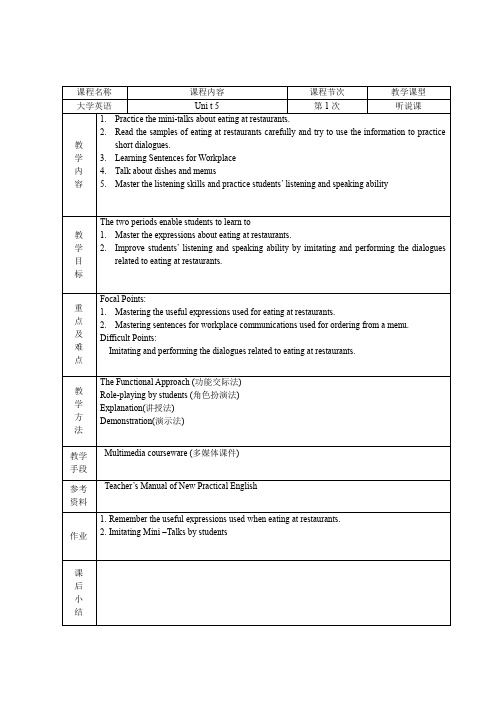
Kim:I’ve got to ask her to hurry things up. I’m thinking of never coming to this restaurant again.
The two periods enable students to learn to
1.Master the expressions abouteating at restaurants.
2.Improve students’ listening and speaking ability by imitating and performing the dialogues related toeating at restaurants.
Jenny: Good. I’d like to try some Shanghai cuisine.
4) May I have a bit more of this wine?
Zhang: May I have a bit more of this wine?
Steven: Sure. Let me pour it for you. Say when.
7.Will you try some seafood?
8.May I have the menu, please?
9.I’d rather have some light food today.
10.Waitress, bring me the bill, please.
Key:1.您想喝点什么吗?
WORD教案【优秀4篇】
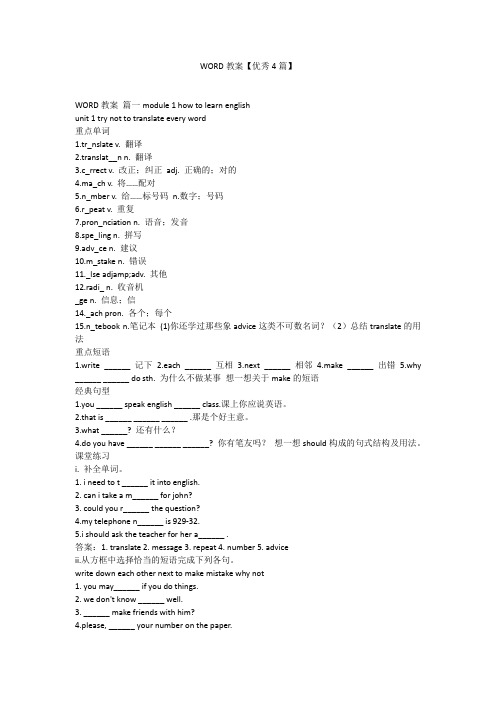
WORD教案【优秀4篇】WORD教案篇一module 1 how to learn englishunit 1 try not to translate every word重点单词1.tr_nslate v. 翻译2.translat__n n. 翻译3.c_rrect v. 改正;纠正adj. 正确的;对的4.ma_ch v. 将……配对5.n_mber v. 给……标号码n.数字;号码6.r_peat v. 重复7.pron_nciation n. 语音;发音8.spe_ling n. 拼写9.adv_ce n. 建议10.m_stake n. 错误11._lse adjamp;adv. 其他12.radi_ n. 收音机_ge n. 信息;信14._ach pron. 各个;每个15.n_tebook n.笔记本(1)你还学过那些象advice这类不可数名词?(2)总结translate的用法重点短语1.write ______ 记下2.each ______ 互相3.next ______ 相邻4.make ______ 出错5.why ______ ______ do sth. 为什么不做某事想一想关于make的短语经典句型1.you ______ speak english ______ class.课上你应说英语。
2.that is ______ ______ ______ .那是个好主意。
3.what ______? 还有什么?4.do you have ______ ______ ______? 你有笔友吗?想一想should构成的句式结构及用法。
课堂练习i. 补全单词。
1. i need to t ______ it into english.2. can i take a m______ for john?3. could you r______ the question?4.my telephone n______ is 929-32.5.i should ask the teacher for her a______ .答案:1. translate 2. message 3. repeat 4. number 5. adviceii.从方框中选择恰当的短语完成下列各句。
新起点大学英语电子教案
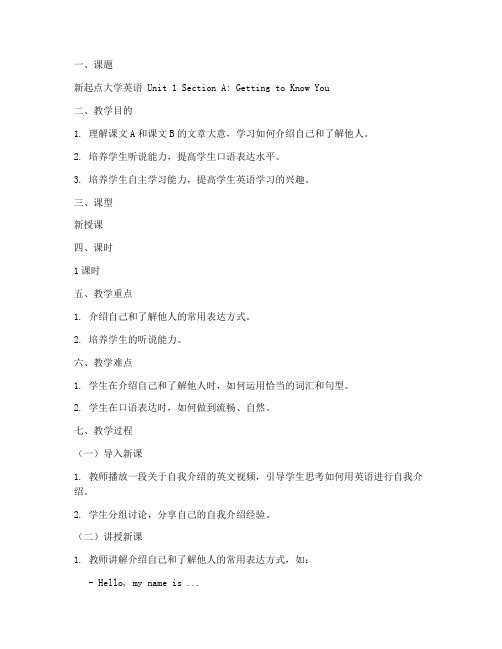
一、课题新起点大学英语 Unit 1 Section A: Getting to Know You二、教学目的1. 理解课文A和课文B的文章大意,学习如何介绍自己和了解他人。
2. 培养学生听说能力,提高学生口语表达水平。
3. 培养学生自主学习能力,提高学生英语学习的兴趣。
三、课型新授课四、课时1课时五、教学重点1. 介绍自己和了解他人的常用表达方式。
2. 培养学生的听说能力。
六、教学难点1. 学生在介绍自己和了解他人时,如何运用恰当的词汇和句型。
2. 学生在口语表达时,如何做到流畅、自然。
七、教学过程(一)导入新课1. 教师播放一段关于自我介绍的英文视频,引导学生思考如何用英语进行自我介绍。
2. 学生分组讨论,分享自己的自我介绍经验。
(二)讲授新课1. 教师讲解介绍自己和了解他人的常用表达方式,如:- Hello, my name is ...- I come from ...- I'm a student at ...- I'm interested in ...- What about you?- I'm from ...- I study ...- I like ...2. 教师引导学生进行角色扮演,模拟介绍自己和了解他人的场景。
(三)巩固练习1. 学生分组进行自我介绍,其他同学提问,了解对方的个人信息。
2. 教师组织学生进行小组讨论,分享自己学到的介绍自己和了解他人的表达方式。
(四)归纳小结1. 教师总结本节课的重点内容,强调介绍自己和了解他人的常用表达方式。
2. 学生分享自己的学习心得,总结自己在本节课中的收获。
(五)作业布置1. 学生课后练习自我介绍,并用英语写一篇关于自己的短文。
2. 学生预习下一节课的内容,为下一节课做好充分准备。
八、板书设计1. 介绍自己和了解他人的常用表达方式2. 学生自我介绍示例3. 小组讨论成果展示九、教具1. 投影仪2. 白板3. 录音笔4. 学生自我介绍视频通过本节课的学习,学生能够掌握介绍自己和了解他人的常用表达方式,提高口语表达能力,为今后的英语学习打下坚实基础。
大学明德英语电子教案
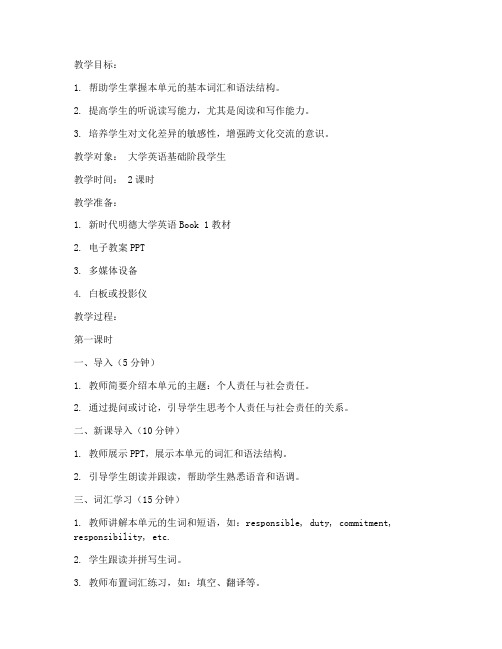
教学目标:1. 帮助学生掌握本单元的基本词汇和语法结构。
2. 提高学生的听说读写能力,尤其是阅读和写作能力。
3. 培养学生对文化差异的敏感性,增强跨文化交流的意识。
教学对象:大学英语基础阶段学生教学时间: 2课时教学准备:1. 新时代明德大学英语Book 1教材2. 电子教案PPT3. 多媒体设备4. 白板或投影仪教学过程:第一课时一、导入(5分钟)1. 教师简要介绍本单元的主题:个人责任与社会责任。
2. 通过提问或讨论,引导学生思考个人责任与社会责任的关系。
二、新课导入(10分钟)1. 教师展示PPT,展示本单元的词汇和语法结构。
2. 引导学生朗读并跟读,帮助学生熟悉语音和语调。
三、词汇学习(15分钟)1. 教师讲解本单元的生词和短语,如:responsible, duty, commitment, responsibility, etc.2. 学生跟读并拼写生词。
3. 教师布置词汇练习,如:填空、翻译等。
四、语法学习(10分钟)1. 教师讲解本单元的语法点:现在进行时。
2. 学生跟读并造句。
3. 教师布置语法练习,如:完成句子、改错等。
五、阅读理解(15分钟)1. 教师引导学生阅读课文,理解文章大意。
2. 学生回答问题,检查阅读效果。
3. 教师总结文章主题,讲解文化背景。
六、课堂小结(5分钟)1. 教师总结本节课的重点内容,如:词汇、语法、阅读理解等。
2. 学生回顾所学内容,提出疑问。
第二课时一、复习(10分钟)1. 教师带领学生复习上一节课的生词、语法和阅读理解内容。
2. 学生回答问题,巩固所学知识。
二、写作练习(20分钟)1. 教师布置写作任务:以“个人责任与社会责任”为主题,写一篇短文。
2. 学生分组讨论,构思文章结构。
3. 学生完成写作,教师批改。
三、课堂小结(5分钟)1. 教师总结本节课的重点内容,如:写作技巧、文化差异等。
2. 学生回顾所学内容,提出疑问。
四、作业布置1. 复习本单元的生词和语法。
小学英语优质教案详案
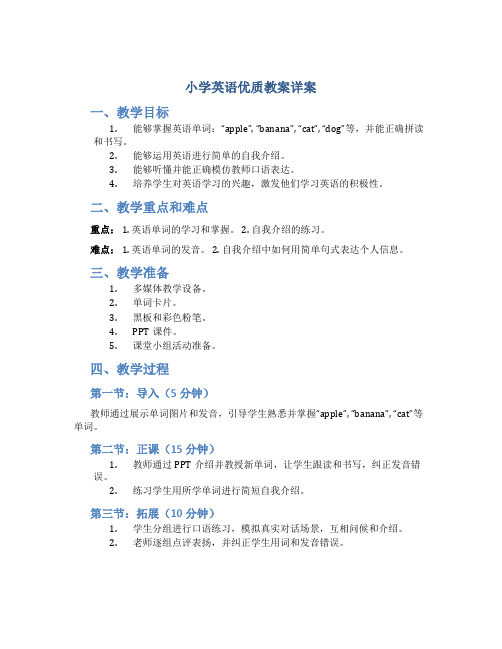
小学英语优质教案详案一、教学目标1.能够掌握英语单词:“apple”, “banana”, “cat”, “dog”等,并能正确拼读和书写。
2.能够运用英语进行简单的自我介绍。
3.能够听懂并能正确模仿教师口语表达。
4.培养学生对英语学习的兴趣,激发他们学习英语的积极性。
二、教学重点和难点重点: 1. 英语单词的学习和掌握。
2. 自我介绍的练习。
难点: 1. 英语单词的发音。
2. 自我介绍中如何用简单句式表达个人信息。
三、教学准备1.多媒体教学设备。
2.单词卡片。
3.黑板和彩色粉笔。
4.PPT课件。
5.课堂小组活动准备。
四、教学过程第一节:导入(5分钟)教师通过展示单词图片和发音,引导学生熟悉并掌握“apple”, “banana”, “cat”等单词。
第二节:正课(15分钟)1.教师通过PPT介绍并教授新单词,让学生跟读和书写,纠正发音错误。
2.练习学生用所学单词进行简短自我介绍。
第三节:拓展(10分钟)1.学生分组进行口语练习,模拟真实对话场景,互相问候和介绍。
2.老师逐组点评表扬,并纠正学生用词和发音错误。
第四节:总结(5分钟)老师和学生共同总结当天学习内容,并展望下节课内容。
五、板书设计英语单词英文发音中文意思apple /ˈæpəl/ 苹果banana /bəˈnɑːnə/香蕉cat /kæt/ 猫dog /dɔːɡ/狗六、教学反思通过本节课的教学,发现学生对于单词发音的掌握仍有待加强,下次课可加入更多发音练习。
同时,学生在自我介绍中表达较为生涩,需要进一步练习句型和流利度。
打算增加更多口语练习时间,提高学生的英语口语表达能力。
以上是本次小学英语优质教案详案,希望对教学工作有所帮助。
九年级英语教案及反思全一册电子版
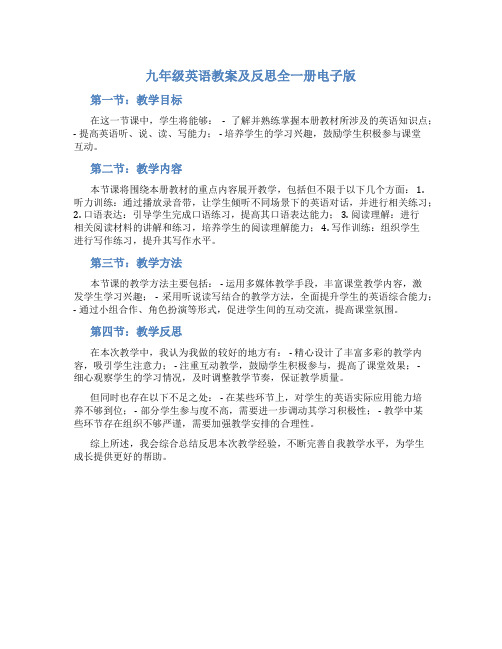
九年级英语教案及反思全一册电子版
第一节:教学目标
在这一节课中,学生将能够:- 了解并熟练掌握本册教材所涉及的英语知识点;- 提高英语听、说、读、写能力; - 培养学生的学习兴趣,鼓励学生积极参与课堂
互动。
第二节:教学内容
本节课将围绕本册教材的重点内容展开教学,包括但不限于以下几个方面: 1.
听力训练:通过播放录音带,让学生倾听不同场景下的英语对话,并进行相关练习;
2. 口语表达:引导学生完成口语练习,提高其口语表达能力;
3. 阅读理解:进行
相关阅读材料的讲解和练习,培养学生的阅读理解能力; 4. 写作训练:组织学生
进行写作练习,提升其写作水平。
第三节:教学方法
本节课的教学方法主要包括: - 运用多媒体教学手段,丰富课堂教学内容,激
发学生学习兴趣; - 采用听说读写结合的教学方法,全面提升学生的英语综合能力;- 通过小组合作、角色扮演等形式,促进学生间的互动交流,提高课堂氛围。
第四节:教学反思
在本次教学中,我认为我做的较好的地方有: - 精心设计了丰富多彩的教学内容,吸引学生注意力; - 注重互动教学,鼓励学生积极参与,提高了课堂效果; -
细心观察学生的学习情况,及时调整教学节奏,保证教学质量。
但同时也存在以下不足之处: - 在某些环节上,对学生的英语实际应用能力培
养不够到位; - 部分学生参与度不高,需要进一步调动其学习积极性; - 教学中某
些环节存在组织不够严谨,需要加强教学安排的合理性。
综上所述,我会综合总结反思本次教学经验,不断完善自我教学水平,为学生
成长提供更好的帮助。
大学英语_授课电子教案
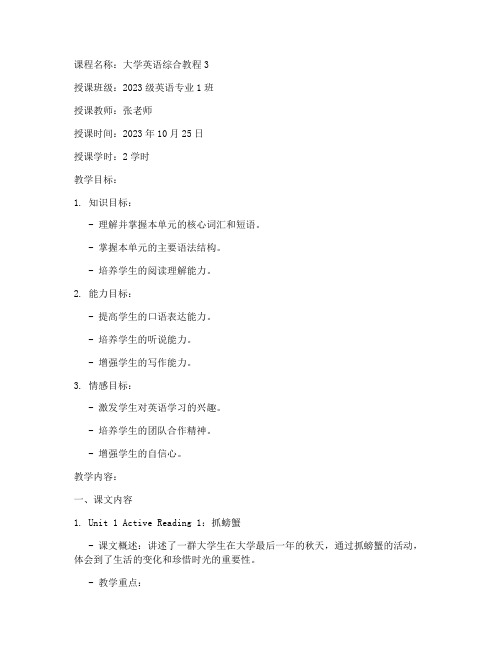
课程名称:大学英语综合教程3授课班级:2023级英语专业1班授课教师:张老师授课时间:2023年10月25日授课学时:2学时教学目标:1. 知识目标:- 理解并掌握本单元的核心词汇和短语。
- 掌握本单元的主要语法结构。
- 培养学生的阅读理解能力。
2. 能力目标:- 提高学生的口语表达能力。
- 培养学生的听说能力。
- 增强学生的写作能力。
3. 情感目标:- 激发学生对英语学习的兴趣。
- 培养学生的团队合作精神。
- 增强学生的自信心。
教学内容:一、课文内容1. Unit 1 Active Reading 1:抓螃蟹- 课文概述:讲述了一群大学生在大学最后一年的秋天,通过抓螃蟹的活动,体会到了生活的变化和珍惜时光的重要性。
- 教学重点:- 理解课文大意,掌握文章结构。
- 学习并运用课文中的重点词汇和短语。
- 分析作者的观点和态度。
2. Unit 1 Active Reading 2:教育的启示- 课文概述:通过一位老师对学生的教育故事,引导学生思考教育的真谛。
- 教学重点:- 理解课文大意,掌握文章结构。
- 学习并运用课文中的重点词汇和短语。
- 分析作者的教育理念。
二、课堂活动1. 课堂导入:- 通过图片、视频等形式,引入本单元主题。
- 引导学生思考:教育的真谛是什么?2. 课堂讨论:- 分组讨论课文中的重点问题,如:- 文章中提到的抓螃蟹活动有什么意义?- 教师的教育故事对你有什么启示?- 鼓励学生用英语表达自己的观点。
3. 角色扮演:- 以课文中的故事为背景,让学生进行角色扮演,提高学生的口语表达能力。
4. 写作练习:- 根据课文内容,写一篇短文,如:- 我的大学时光- 我对教育的理解三、教学手段1. 多媒体教学:利用PPT、视频、音频等多媒体手段,丰富课堂内容,提高学生的学习兴趣。
2. 小组合作:通过小组讨论、角色扮演等活动,培养学生的团队合作精神。
3. 课堂互动:鼓励学生积极参与课堂活动,提高学生的课堂参与度。
高中英语电子教案
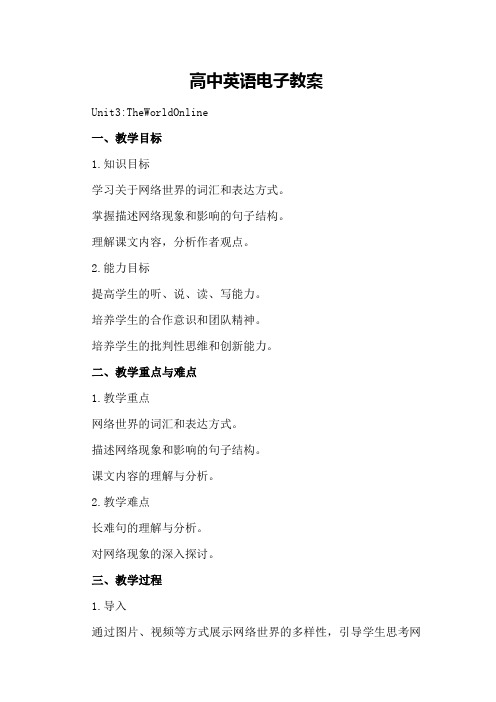
高中英语电子教案Unit3:TheWorldOnline一、教学目标1.知识目标学习关于网络世界的词汇和表达方式。
掌握描述网络现象和影响的句子结构。
理解课文内容,分析作者观点。
2.能力目标提高学生的听、说、读、写能力。
培养学生的合作意识和团队精神。
培养学生的批判性思维和创新能力。
二、教学重点与难点1.教学重点网络世界的词汇和表达方式。
描述网络现象和影响的句子结构。
课文内容的理解与分析。
2.教学难点长难句的理解与分析。
对网络现象的深入探讨。
三、教学过程1.导入通过图片、视频等方式展示网络世界的多样性,引导学生思考网络对生活的影响。
2.新课导入学习课文第一段,了解网络世界的概况。
学习词汇:Internet,online,website,browser,searchengine等。
3.课文学习分组阅读课文,理解课文内容。
分析课文结构,找出主题句和支撑句。
讨论课文中的观点,提出自己的看法。
4.课堂活动分组进行网络调查,了解同学们的网络使用情况。
每组汇报调查结果,讨论网络对学习和生活的影响。
5.语言实践学生根据课文内容,编写一篇关于网络利弊的短文。
分组讨论,互相修改,提高写作能力。
6.课堂小结布置作业:写一篇关于网络安全的文章。
四、课后作业1.完成课后练习。
2.预习下一课内容,准备课堂讨论。
五、教学反思本节课通过学习网络世界的词汇和表达方式,让学生了解网络对生活的影响,培养学生的批判性思维和创新能力。
在课堂活动中,同学们积极参与,讨论热烈,对网络现象有了更深入的认识。
在今后的教学中,要继续关注学生的个性化需求,提高教学效果。
六、教学拓展1.举办网络知识竞赛,提高学生对网络的认识。
2.组织网络实践活动,让学生亲身体验网络的利弊。
3.邀请专家进行网络安全讲座,提高学生的网络安全意识。
七、教学资源1.课文原文及配套练习。
2.网络相关图片、视频素材。
3.网络安全知识资料。
八、教学评价1.课堂表现:观察学生在课堂上的参与度、发言积极性等。
大学英语电子教案设计
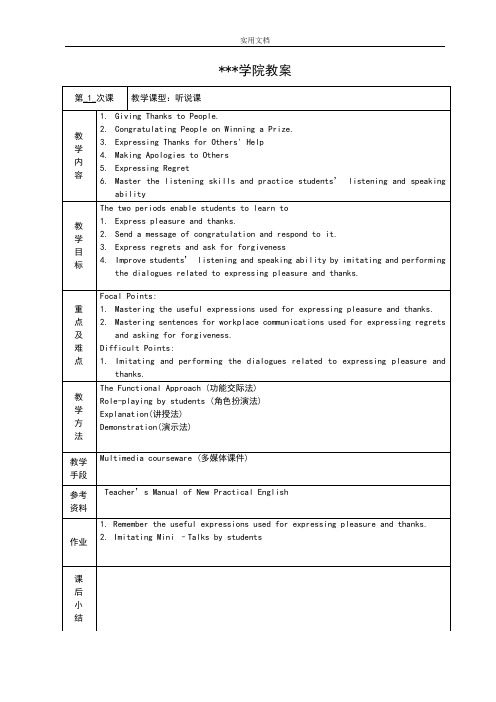
点
及
难
点
Focal Points:
1.Mastering the useful expressions used for expressing pleasure and thanks.
2.Mastering sentences for workplace communications used for expressing regrets and asking for forgiveness.
5) Expressing Regret
A: I'm sorry I didn't send the e-mail yesterday.
B: Forget it. That's OK.
A: I wish I could make up for it.
B: I don't think it's your fault.
A) I owe it to your help. B) What a surprise!
C) It can't be true! D) Good luck!
B: It’s also our great pleasure.
Task 2: Congratulate your friend on being admitted to a nursing school.
A: Congratulations! You are admitted to a nursing school.
B: Thanks. You know I’ve been dreaming to be a nurse.
A: This MP4 is a gift for you.
B: Oh, how beautiful! Thank you very much indeed.
初中教案英语电子模板

初中教案英语电子模板课程名称:初中英语年级:八年级教材版本:人教版教材章节:Unit 2 I'd like some potatoes, please.教学目标:1. 能够听懂、会说、会读本课的生词和重点句子。
2. 能够运用所学知识进行简单的日常交流。
3. 能够理解并在适当的情境中运用一般现在时。
教学重点:1. 一般现在时的用法。
2. 祈使句、一般疑问句及其回答。
教学难点:1. 一般现在时的动词形式。
2. 祈使句的构成及用法。
教学准备:1. 电子教材、PPT。
2. 单词卡片、图片。
3. 录音机、磁带。
教学过程:Step 1: Lead-in(5分钟)1. 教师与学生用英语进行自由对话,询问学生昨天做了什么。
2. 引导学生谈论日常生活中的事物,如食物、衣物、学习用品等。
Step 2: Presentation(15分钟)1. 教师展示PPT,介绍本课的生词和句子。
2. 教师用实物或图片展示单词,引导学生说出单词。
3. 教师引导学生模仿发音,注意发音准确性。
4. 教师用PPT展示一般现在时的句子,引导学生理解并运用。
Step 3: Practice(15分钟)1. 教师组织学生进行小组活动,用英语进行交流。
2. 学生运用一般现在时进行对话,教师巡回指导。
3. 教师选取部分学生进行对话展示,给予评价。
Step 4: Consolidation(10分钟)1. 教师设计一个情境,让学生运用一般现在时进行角色扮演。
2. 学生分组进行角色扮演,教师巡回指导。
3. 教师选取部分学生进行表演展示,给予评价。
Step 5: Summary(5分钟)1. 教师引导学生总结本节课所学内容。
2. 学生分享自己的学习收获。
Step 6: Homework(5分钟)1. 教师布置作业,要求学生复习本课内容,巩固所学知识。
2. 学生领取作业,认真完成。
教学反思:本节课通过电子教材和PPT的使用,有效地辅助了教学,提高了学生的学习兴趣。
人教版九年级英语 Unit3 优质课教案(全)
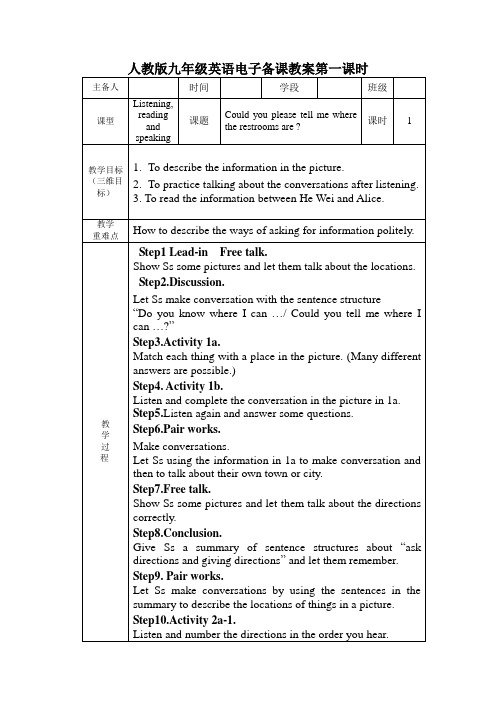
Step7.Free talk.
Show Ss some pictures and let them talk about the directions correctly.
nguage points:
explain the key words and phrases in section A-2
教学
反思
人教版九年级英语电子备课教案第三课时
时间
学段
班级
课型
Gou tell me where the restroom are ?
—Sorry,I’m not sure how to get there.
3.Iwonder where we should go next.
—You should try that new ride over there.
4.Could you tell us when the band starts playing this evening?
Step7.More exercises.
1.Choosing the right answers.
plete sentences.
3.Exchanges of sentence structures.
The exercises of Secondary School Entrance Exams
Step8.Conclusion.
Give Ss a summary ofsentencestructures about“ask directions and giving directions”and let them remember.
小学英语教案电子版模板

课时:2课时年级:四年级教材:《PEP小学英语》四年级上册教学目标:1. 知识目标:(1)学生能够听懂、会说、会写关于家庭成员的单词:father, mother, brother, sister, grandpa, grandma。
(2)学生能够运用所学词汇和句型进行简单的对话。
2. 能力目标:(1)培养学生听、说、读、写的基本技能。
(2)提高学生的英语口语表达能力。
3. 情感目标:(1)让学生了解自己的家庭,增进家庭成员之间的感情。
(2)培养学生热爱家庭、尊敬长辈的情感。
教学重点:1. 识记和运用家庭成员的单词。
2. 学会运用句型“Who is this?”和“His/Her name is…”进行对话。
教学难点:1. 正确发音家庭成员的单词。
2. 运用所学句型进行对话。
教学过程:第一课时一、热身活动(Warm-up)1. 老师带领学生唱一首关于家庭的英文歌曲,如《Family, Family, I love you》。
2. 学生自由发言,介绍自己的家庭成员。
二、新课导入(Introduction)1. 老师出示一张家庭成员的图片,引导学生说出图片中的人物。
2. 老师板书家庭成员的单词:father, mother, brother, sister, grandpa, grandma。
三、词汇学习(Vocabulary Learning)1. 老师带领学生读单词,并纠正发音。
2. 学生跟读单词,并分组进行单词接龙游戏。
四、句型练习(Sentence Practice)1. 老师出示一张家庭成员的图片,引导学生用句型“Who is this?”进行提问。
2. 学生分组进行对话练习,运用句型“His/Her name is…”介绍家庭成员。
五、巩固练习(Consolidation)1. 老师播放一段关于家庭的英文视频,让学生根据视频内容回答问题。
2. 学生分组进行角色扮演,模拟家庭场景。
六、课堂小结(Summary)1. 老师总结本节课所学内容,强调家庭成员的单词和句型。
高一英语完整教案电子版
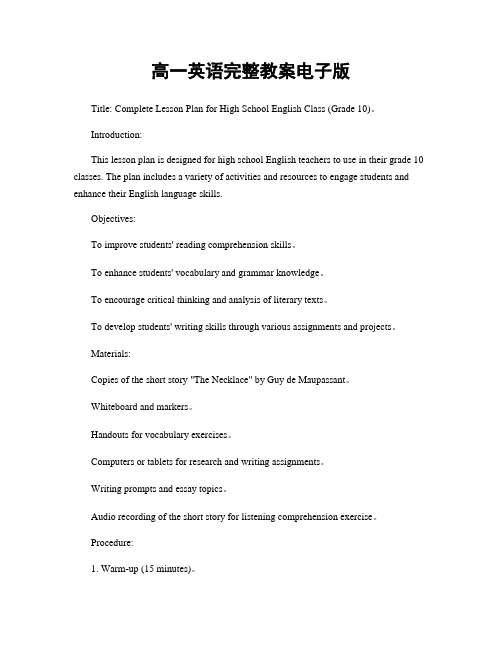
高一英语完整教案电子版Title: Complete Lesson Plan for High School English Class (Grade 10)。
Introduction:This lesson plan is designed for high school English teachers to use in their grade 10 classes. The plan includes a variety of activities and resources to engage students and enhance their English language skills.Objectives:To improve students' reading comprehension skills。
To enhance students' vocabulary and grammar knowledge。
To encourage critical thinking and analysis of literary texts。
To develop students' writing skills through various assignments and projects。
Materials:Copies of the short story "The Necklace" by Guy de Maupassant。
Whiteboard and markers。
Handouts for vocabulary exercises。
Computers or tablets for research and writing assignments。
Writing prompts and essay topics。
Audio recording of the short story for listening comprehension exercise。
优秀英语电子教案设计模板

一、课程基本信息1. 课程名称: [课程名称]2. 授课教师: [教师姓名]3. 授课班级: [班级名称]4. 授课时间: [具体时间]5. 授课地点: [具体地点]6. 教学目标:- 知识目标:[具体知识点]- 能力目标:[具体能力培养]- 情感目标:[具体情感态度价值观培养]二、教学过程1. 导入(Warm-up)- 活动目的:激发学生学习兴趣,复习相关知识点。
- 活动内容:- 通过播放歌曲、图片、视频等,引入主题。
- 进行简单的问答或游戏,引导学生复习旧知识。
2. 新授(Presentation)- 活动目的:讲解新知识点,帮助学生理解。
- 活动内容:- 利用PPT、多媒体资源展示新知识点。
- 通过实物、模型等辅助教学工具,直观展示教学内容。
- 结合实际情境,讲解语法、词汇等知识点。
3. 练习(Practice)- 活动目的:巩固所学知识,提高学生运用能力。
- 活动内容:- 设计多种形式的练习题,如填空、选择题、匹配题等。
- 进行小组讨论或角色扮演,让学生在实际语境中运用所学知识。
- 通过游戏、竞赛等形式,提高学生的学习兴趣。
4. 巩固(Consolidation)- 活动目的:帮助学生巩固所学知识,提高语言运用能力。
- 活动内容:- 进行写作、口语表达等练习,让学生运用所学知识解决问题。
- 组织学生进行小组合作,共同完成任务。
- 通过展示、评价等形式,提高学生的自信心。
5. 总结(Summary)- 活动目的:梳理本节课所学知识,帮助学生形成完整的知识体系。
- 活动内容:- 教师对本节课所学知识进行总结,强调重点、难点。
- 学生分享学习心得,提出疑问。
- 布置课后作业,巩固所学知识。
三、教学资源1. 多媒体资源:PPT、视频、音频、图片等。
2. 教材:[教材名称]3. 辅助教材:[辅助教材名称]4. 网络资源:[相关网站、论坛、博客等]四、教学反思1. 教学目标的达成情况。
2. 教学方法的适用性。
英语教案初中优秀教案模板
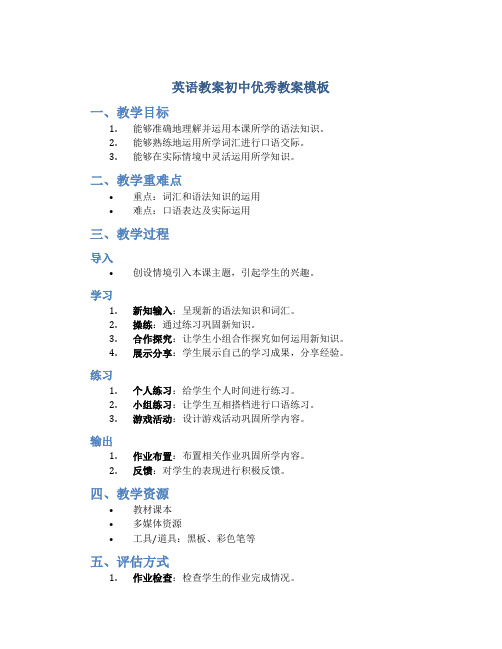
英语教案初中优秀教案模板
一、教学目标
1.能够准确地理解并运用本课所学的语法知识。
2.能够熟练地运用所学词汇进行口语交际。
3.能够在实际情境中灵活运用所学知识。
二、教学重难点
•重点:词汇和语法知识的运用
•难点:口语表达及实际运用
三、教学过程
导入
•创设情境引入本课主题,引起学生的兴趣。
学习
1.新知输入:呈现新的语法知识和词汇。
2.操练:通过练习巩固新知识。
3.合作探究:让学生小组合作探究如何运用新知识。
4.展示分享:学生展示自己的学习成果,分享经验。
练习
1.个人练习:给学生个人时间进行练习。
2.小组练习:让学生互相搭档进行口语练习。
3.游戏活动:设计游戏活动巩固所学内容。
输出
1.作业布置:布置相关作业巩固所学内容。
2.反馈:对学生的表现进行积极反馈。
四、教学资源
•教材课本
•多媒体资源
•工具/道具:黑板、彩色笔等
五、评估方式
1.作业检查:检查学生的作业完成情况。
2.口头表达:观察学生在口语练习中的表现。
3.小组合作:评估学生在小组合作中的积极性和贡献度。
六、课后反思
•总结本节课的教学过程,优点和不足之处,并针对不足之处做出改进。
以上是本节课的教案模板,希望能够对英语教学有所帮助。
- 1、下载文档前请自行甄别文档内容的完整性,平台不提供额外的编辑、内容补充、找答案等附加服务。
- 2、"仅部分预览"的文档,不可在线预览部分如存在完整性等问题,可反馈申请退款(可完整预览的文档不适用该条件!)。
- 3、如文档侵犯您的权益,请联系客服反馈,我们会尽快为您处理(人工客服工作时间:9:00-18:30)。
英语教案-电子教案课题Unit 1. My classroom.共6课时教学目标 1. Make the students describe their own classroom with simple words.2.Tell the colours of the objects of the classroom.3. Learn the words and sentences in Part A,B.4. Sing the song “In th e classroom” and understand the story. 教学重点教学难点 Get thepupils to describe their classroom in their own words. 教学准备Tape and recorder, stickers and word cards. 教学过程Period 11. Warm-up:T: Hello, A! Welcome back to school!A: Hello, Mis s…. Nice to see you again.T: Nice to see you, too.2. Presentation:(1) Show the picture of the classroom and say: Thisis my classroom. What can you see in it? Present the words: window, door, picture, light, board, floor. Read aloud.(2) Practise the words, using the patterns: Where is ….? It’s on the….e.g. Drawa bag on the board, asking: Where’s the bag? Get the answer: Onthe board.(3) Game: Let the students have the word cards in their hands. The teacher gives the order: Show me your pictu re/window/…The students show the word cards.(4) Listen to the tape, get the students read after the tape.(5) Presentation of the new phrases: Open the door. Sweep the floor. Turn on the light. Clean the window.Put up the picture. Clean the board. Read and act.(6) Learn tosing the song: In the classroom.3. Consolidation and extension.Do the exercises in the Activity Book. Period 21. Warm-up:Practise everyday English:A: Hello,B! This is….B: Hello,C! Nice to meet you, too.C: Let’s go to school.B&C: OK!2. Preview:(1) Listen to the tape for Part A, Let’s do. Read and act.(2) Show the picture of Zhang Peng, introduce him to the students. 修改意见课题Unit 1. My classroom.共6课时教学目标 1. Make the students describe their own classroom with simple words.2.Tell the colours of the objects of the classroom.3. Learn the words and sentences in Part A,B.4. Sing the song “In the classroom” and understand the story. 教学重点教学难点 Get thepupils to describe their classroom in their own words. 教学准备Tape and recorder, stickers and word cards. 教学过程Period 11. Warm-up:T: Hello, A! Welcome back to school!A: Hello, Miss…. Nice to see you again.T: Nice to see you, too.2. Presentation:(1) Show the picture of the classroom and say: Thisis my classroom. What can you see in it? Present the words: window, door, picture, light, board, floor. Read aloud.(2) Practise the words, using the patterns: Where is ….? It’s on the….e.g. Drawa bag on the board, asking: Where’s the bag? Get the answer: Onthe board.(3) Game: Let the students have the word cards in theirhands. The teacher gives the order: Show me your picture/window/…The students show the word cards.(4) Listen to the tape, get the students read after the tape.(5) Presentation of the new phrases: Open the door. Sweep the floor. Turn on the light. Clean the window.Put up the picture. Clean the board. Read and act.(6) Learn tosing the song: In the classroom.3. Consolidation and extension.Do the exercises in the Activity Book. Period 21. Warm-up:Practise everyday English:A: Hello,B! This is….B: Hello,C! Nice to meet you, too.C: Let’s go to school.B&C: OK!2. Preview:(1) Listen to the tape for Part A, Let’s do. Read and act.(2) Show the picture of Zhang Peng, introduce him to the students. 修改意见课题Unit 1. My classroom.共6课时教学目标 1. Make the students describe their own classroom with simple words.2.Tell the colours of the objects of the classroom.3. Learn the words and sentences in Part A,B.4. Sing the song “In the classroom” and understand the story. 教学重点教学难点 Get thepupils to describe their classroom in their own words. 教学准备Tape and recorder, stickers and word cards. 教学过程Period 11. Warm-up:T: Hello, A! Welcome back to school!A: Hello, Miss…. Nice to see you again.T: Nice to see you, too.2. Presentation:(1) Show the picture of the classroom and say: Thisis my classroom. What can you see in it? Present the words: window, door, picture, light, board, floor. Read aloud.(2) Practise the words, using the patterns: Where is ….? It’s on the….e.g. Draw a bag on the board, asking: Where’s the bag? Get the answer: On the board.(3) Game: Let the students have the word cards in their hands. The teacher gives the order: Show me your picture/window/… The students show the word cards.(4) Listen to the tape, get the students read after the tape.(5) Presentation of the new phrases: Open the door. Sweep the floor. Turn on the light. Clean the window. Put up the picture. Clean the board. Read and act.(6) Learn to sing the song: In the classroom.3. Consolidation and extension.Do the exercises in the Activity Book. Period 21. Warm-up:Practise everyday English:A: Hello,B! This is….B: Hello,C! Nice to meet you, too.C: Let’s go to school.B&C: OK!2. Preview:(1) Listen to the tape for Part A, Let’s do. Read and act.(2) Show the picture of Zhang Peng, introduce him to the students. 修改意见课题Unit 1. My classroom.共6课时教学目标 1. Make the students describe their own classroom with simple words.2. Tell the colours of the objects of the classroom.3. Learn the words and sentences in Part A,B.4. Sing the song “In the classroom” and understand t he story. 教学重点教学难点 Get thepupils to describe their classroom in their own words. 教学准备Tape and recorder, stickers and word cards. 教学过程Period 11. Warm-up:T: Hello, A! Welcome back to school!A: Hello, Miss…. Nice to see you again.T: Nice to see you, too.2. Presentation:(1) Show the picture of the classroom and say: Thisis my classroom. What can you see in it? Present the words: window, door, picture, light, board, floor. Read aloud.(2) Practise the words, using the patter ns: Where is ….? It’s on the….e.g. Drawa bag on the board, asking: Where’s the bag? Get the answer: Onthe board.(3) Game: Let the students have the word cards in their hands. The teacher gives the order: Show me your picture/window/…The students show the word cards.(4) Listen to the tape, get the students read after the tape.(5) Presentation of the new phrases: Open the door. Sweep the floor. Turn on the light. Clean the window.Put up the picture. Clean the board. Read and act.(6) Learn tosing the song: In the classroom.3. Consolidation and extension.Do the exercises in the Activity Book. Period 21. Warm-up:Practise everyday English:A: Hello,B! This is….B: Hello,C! Nice to meet you, too.C: Let’s go to school.B&C: OK!2.Prev iew:(1) Listen to the tape for Part A, Let’s do. Read and act.(2) Show the picture of Zhang Peng, introduce him to the students. 修改意见课题Unit 1. My classroom.共6课时教学目标 1. Make the students describe their own classroom with simple words.2.Tell the colours of the objects of the classroom.3. Learn the words and sentences in Part A,B.4. Sing the song “In the classroom” and understand the story. 教学重点教学难点 Get thepupils to describe their classroom in their own words. 教学准备Tape and recorder, stickers and word cards. 教学过程Period 11. Warm-up:T: Hello, A! Welcome back to school!A: Hello, Miss…. Nice to see you again.T: Nice to see you, too.2. Presentation:(1) Show the picture of the classroom and say: Thisis my classroom. What can you see in it? Present the words: window, door, picture, light, board, floor. Read aloud.(2) Practise the words, using the patterns: Where is ….? It’s on the….e.g. Drawa bag on the board, asking: Where’s the bag? Get the an swer: Onthe board.(3) Game: Let the students have the word cards in their hands. The teacher gives the order: Show me your picture/window/…The students show the word cards.(4) Listen to the tape, get the students read after the tape.(5) Presentation of the new phrases: Open the door. Sweep the floor. Turn on the light. Clean the window.Put up the picture. Clean the board. Read and act.(6) Learn tosing the song: In the classroom.3. Consolidation and extension.Do the exercises in the Activity Book. Period 21.Warm-up:Practise everyday English:A: Hello,B! This is….B: Hello,C! Nice to meet you, too.C: Let’s go to school.B&C: OK!2. Preview:(1) Listen to the tape for Part A, Let’s do. Read and act.(2) Show the picture of Zhang Peng, introduce him to the students. 修改意见课题Unit 1. My classroom.共6课时教学目标 1. Make the students describe their own classroom with simple words.2.Tell the colours of the objects of the classroom.3. Learn the words and sentences in P art A,B.4. Sing the song “In the classroom” and understand the story. 教学重点教学难点 Get thepupils to describe their classroom in their own words. 教学准备Tape and recorder, stickers and word cards. 教学过程Period 11. Warm-up:T: Hello, A! Welcome back to school!A: Hello, Miss…. Nice to see you again.T: Nice to see you, too.2. Presentation:(1) Show the picture of the classroom and say: Thisis my classroom. What can you see in it? Present the words: window, door, picture, light, board, floor. Read aloud.(2) Practise the words, using the patterns: Where is ….? It’s on the….e.g. Drawa bag on the board, asking: Where’s the bag? Get the answer: Onthe board.(3) Game: Let the students have the word cards in their hands. The teache r gives the order: Show me your picture/window/…The students show the word cards.(4) Listen to the tape, get thestudents read after the tape.(5) Presentation of the new phrases: Open the door. Sweep the floor. Turn on the light. Clean the window.Put up the picture. Clean the board. Read and act.(6) Learn to sing the song: In the classroom.3. Consolidation and extension.Do the exercises in the Activity Book. Period 21. Warm-up:Practise everyday English:A: Hello,B! This is….B: Hello,C! Nice to meet you, too.C: Let’s go to school.B&C: OK!2. Preview:(1) Listen to the tape for Part A, Let’s do. Read and act.(2) Show the picture of Zhang Peng, introduce him to the students. 修改意见课题Unit 1. My classroom.共6课时教学目标 1. Make the students describe their own classroom with simple words.2.Tell the colours of the objects of the classroom.3. Learn the words and sentences in Part A,B.4. Sing the song “In the classroom” and understand the story. 教学重点教学难点 Get the pupils to describe their classroom in their own words. 教学准备Tape and recorder, stickers and word cards. 教学过程Period 11. Warm-up:T: Hello, A! Welcome back to school!A: Hello, Miss…. Nice to see you again.T: Nice to see you, too.2. Presentation:(1) Show the picture of the classroom and say: Thisis my classroom. What can you see in it? Present the words: window, door, picture, light, board, floor. Read aloud.(2) Practise thewords, using the patterns: Where is ….? It’s on the….e.g. Draw a bag on the board, asking: Where’s the bag? Get the answer: On the board.(3) Game: Let the students have the word cards in their hands. The teacher gives the order: Show me your picture/window/… The students show the word cards.(4) Listen to the tape, get the students read after the tape.(5) Presentation of the new phrases: Open the door. Sweep the floor. Turn on the light. Clean the window. Put up the picture. Clean the board. Read and act.(6) Learn to sing the song: In the classroom.3. Consolidation and extension.Do the exercises in the Activity Book. Period 21. Warm-up:Practise everyday English:A: Hello,B! This is….B: Hello,C! Nice to meet you, too.C: Let’s go to school.B&C: OK!2. Preview:(1) Listen to the tape for Part A, Let’s do. Read and act.(2) Show the picture of Zhang Peng, introduce him to the students. 修改意见课题Unit 1. My classroom.共6课时教学目标 1. Make the students describe their own classroom with simple words.2. Tell the colours of the objects of the classroom.3. Learn the words and sentences in Part A,B.4. Sing the song “In the classroom” and understand the story. 教学重点教学难点 Get the pupils to describe their classroom in their own words. 教学准备Tape and recorder, stickers and word cards. 教学过程Period 11. Warm-up:T: Hello, A! Welcome back to school!A: Hello, Miss…. Nice to see you again.T: Nice to see you, too.2. Presentation:(1) Show the picture of the classroom and say: Thisis my classroom. What can you see in it? Present the words: window, door, picture, light, board, floor. Read aloud.(2) Practise the words, using the patterns: Where is ….? It’s on the….e.g. Drawa bag on the board, asking: Where’s the bag? Get the answer: Onthe board.(3) Game: Let the students have the word cards in their hands. The teacher gives the order: Show me your picture/window/…The students show the word cards.(4) Listen to the tape, get the students read after the tape.(5) Presentation of the new phrases: Open the door. Sweep the floor. Turn on the light. Clean the window.Put up the picture. Clean the board. Read and act.(6) Learn tosing the song: In the classroom.3. Consolidation and extension.Do the exercises in the Activity Book. Period 21. Warm-up:Practise everyday English:A: Hello,B! This is….B: Hello,C! Nice to meet you, too.C: Let’s go to school.B&C: OK!2. Preview:(1) Listen to the tape for Part A, Let’s do. Read and act.(2) Show the picture of Zhang Peng, introduce him to the students. 修改意见课题Unit 1. My classroom.共6课时教学目标 1. Make the students describe their own classroom with simple words.2.Tell the colours of the objects of the classroom.3. Learn the words and sentences in Part A,B.4. Sing the son g “In the classroom” and understand the story. 教学重点教学难点 Get thepupils to describe their classroom in their own words. 教学准备Tape and recorder, stickers and word cards. 教学过程Period 11. Warm-up:T: Hello, A! Welcome back to school!A:He llo, Miss…. Nice to see you again.T: Nice to see you, too.2. Presentation:(1) Show the picture of the classroom and say: Thisis my classroom. What can you see in it? Present the words: window, door, picture, light, board, floor. Read aloud.(2) Practise the words, using the patterns: Where is ….? It’s on the….e.g. Drawa bag on the board, asking: Where’s the bag? Get the answer: Onthe board.(3) Game: Let the students have the word cards in their hands. The teacher gives the order: Show me yo ur picture/window/…The students show the word cards.(4) Listen to the tape, get the students read after the tape.(5) Presentation of the new phrases: Open the door. Sweep the floor. Turn on the light. Clean the window.Put up the picture. Clean the board. Read and act.(6) Learn tosing the song: In the classroom.3. Consolidation and extension.Do the exercises in the Activity Book. Period 21. Warm-up:Practise everyday English:A: Hello,B! This is….B: Hello,C! Nice to meet you, too.C: Let’s go to school.B&C: OK!2.Preview:(1) Listen to the tape for Part A, Let’s do. Read and act.(2) Show the picture of Zhang Peng, introduce him to the students. 修改意见课题Unit 1. My classroom.共6课时教学目标 1. Make the students describe their own classroom with simple words.2.Tell the colours of the objects of the classroom.3. Learn the words and sentences in Part A,B.4. Sing the song “In the classroom” and understand the story. 教学重点教学难点 Get thepupils to describe their classroom in their own words. 教学准备Tape and recorder, stickers and word cards. 教学过程Period 11. Warm-up:T: Hello, A! Welcome back to school!A: Hello, Miss…. Nice to see you again.T: Nice to see you, too.2. Presentation:(1) Show the picture of the classroom and say: Thisis my classroom. What can you see in it? Present the words: window, door, picture, light, board, floor. Read aloud.(2) Practise the words, using the patterns: Where is ….? It’s on the….e.g. Drawa bag on the board, asking: Where’s the bag? Get the answer: Onthe board.(3) Game: Let the students have the word cards in their hands. The teacher gives the order: Show me your picture/window/…The students show the word cards.(4) Listen to the tape, get the students read after the tape.(5) Presentation of the new phrases: Open the door. Sweep the floor. Turn on the light. Clean the window.Put up the picture. Clean the board. Read and act.(6) Learn to sing the song: In the classroom.3. Consolidation and extension.Do the exercises in the Activity Book. Period 21. Warm-up:Practise everyday English:A: Hello,B! This is….B: Hello,C! Nice to meet you, too.C: Let’s go to school.B&C: OK!2. Preview:(1) Listen to the tape for Part A, Let’s do. Read a nd act.(2) Show the picture of Zhang Peng, introduce him to the students. 修改意见。
